The seven deadly sins
The late Gothic water hammer figures of the Wintringer Chapel in the mirror of 8 panel paintings by the painter Nikola Dimitrov
Archetype...
For the event "Hibernus" at the cultural site Wintringer Chapel in November 2004 Nikola Dimitrov painted eight panel paintings on the theme of the Seven Deadly Sins in discussion with the allegorical water hammer figures. In his interpretation, he linked the vices that distance man from God and his own soul's path with the symbolism of the planets, which is also familiar to the medieval world of ideas. Since ancient times, the planets have represented inner and outer forces, which place the development of man under a tension of light and shadow. In the polarity of good and evil, between heaven and earth, rise and fall, the deadly sins arrange themselves as extremes of psychic possibilities; also the eighth figure of the angel becomes an ambiguous figure as light bearer and servant of darkness. In the eight pillar-like panel paintings, inspired by Gothic architecture, Dimitrov unfolds a symbolic universe of human individuality with the help of a pictorial language based on color spaces. He thus created a contemporary mirror of self-knowledge that is committed to both the tradition of the "memento mori" and the vision of a holistic becoming human.
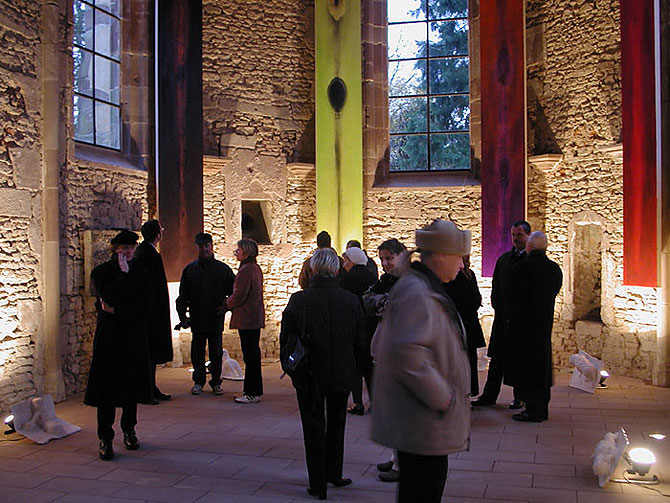
Exhibition opening on November 21, 2004 in the Wintringer Chapel
... and echo
The 8 panels of the Seven Deadly Sins painted in dialogue with the water hammer figures were the inspiring starting point of an artistic metamorphosis. In a two-year process, a spatial and symbolic field of activity grew around the cultural site Wintringer Chapel, which brought people, places, and arts of various disciplines into continuing resonance with the genius loci.
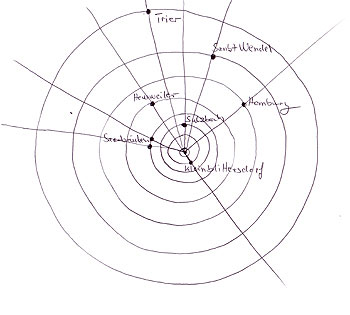
The growing network: Wintringer Chapel, Kleinblittersdorf, two stations in Saarbrücken, Alte Tabakfabrik Heusweiler in the city district, St. Wendel, Sulzbach and Trier.
The Metamorphosis of the Seven Deadly Sins
1. the 100 little sins
For a contribution to the preservation of the cultural site, Nikola Dimitrov created 100 "Small Sins" in 2004. The 100 hand-signed miniatures, worked in Gothic format in exact proportion, were created from the canvas that he had painted in the colors associated with the symbolism of the sun/lion in the approach to his theme. This original image was divided into 100 strips, which were then painted over individually in very individual mixtures of the deadly sin colors. This differentiated sin mosaic let the viewer discover his own sin mirror.
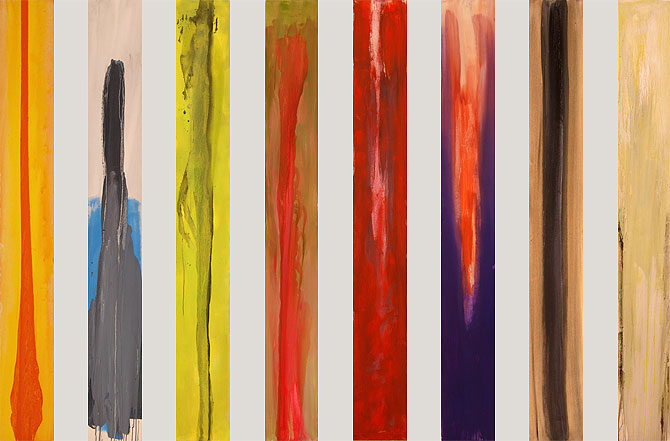
Selection of miniatures of small sins, 34 x 4.4 cm on handmade paper, pigment, binder, solvent on canvas
2. the seven deadly sins in the hospital chapel of saint Wendel
The 5.80 meter high panels created for the Gothic sacred space exceed usual spatial dimensions. Nikola Dimitrov therefore painted eight new pictures in proportional reduction in the beginning of 2005 in the same habitus and similar color scheme, again in the sacral environment in the apse of the chapel of the Hospital St. Wendel.
Nikola Dimitrov painted directly in front of the audience, musically accompanied by Bernd Mathias on piano and Stefan Scheib on bass. The live compositions gave this second painterly interpretation its own depth. Nikola Dimitrov painted under the impression of the symbolism of the water hitting figures in combination with 8 musical leading themes, which illuminated the dark and the bright side of the planet symbolism with the expressive possibilities of the music in 18 sound pictures. This second picture cycle, since 2007 with 4 picture panels in possession of the Saarbrücken Winterberg Clinics, carries the spirit of reflection and contemplative self-discovery to this emotionally difficult place.
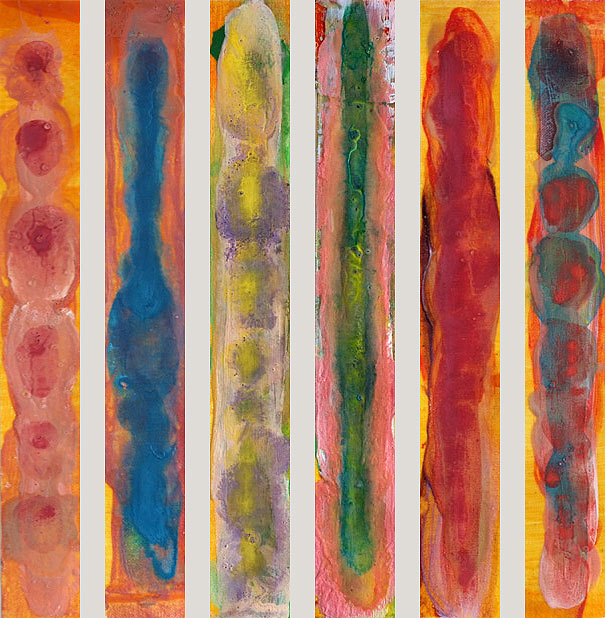
The Seven Deadly Sins / Acrylic and pigment on canvas, 2005, 250 x 30 cm
3. the seven deadly sins as an echo for the exhibition in Kleinblittersdorf
In 2005, the deadly sins returned to the mundane center of their place of origin: for an exhibition in the city hall of Kleinblittersdorf, Nikola Dimitrov painted a second picture cycle in a reduced format. The picture columns were in correspondence with photographic black-and-white images of the water hammer figures and represented an artistic image reflecting the original work. At the same time, the aim was to create a movable installation of the Seven Deadly Sins that could be displayed ubiquitously.
This renewed painterly interpretation already allowed other expressive nuances to appear in the eight-part psychogram formed by the color compositions. The eight picture panels are owned by Evonik Services GmbH in Saarbrücken and confront the commercial environment of the company with the spiritual code of values at their location.
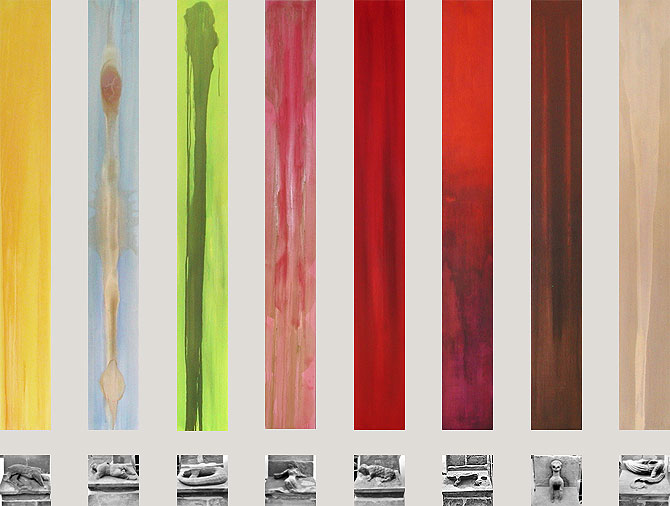
The Seven Deadly Sins / acrylic and pigment on canvas, 2005, 250 x 30 cm
Photos of the 8 water hammer figures / print on canvas, 30 x 30 cm
4. the cycle of the seven deadly sins as a creative act in the cloth factory Trier
In a creative act, Nikola Dimitrov then changed the format and concept in a live painting at Tufa Trier in 2006. The eight paintings grew out of the extreme vertical into a wider, more grounding format. At the same time, he dissolved the fixed sequence following the positions of the water hammer figures in favor of a free, changing sequence of images - a step that was already prefigured in situ in the change of place of the water hammer figures on the outer pillars due to the construction.
Through variable combinations, different overall images could now be created that reordered and reweighted the medieval canon of sin. The surprising effects led to new approaches to interpretation. Supported by the more expressive, disharmonious color space, the new design freedom signaled the abandonment of the traditional religious moral context. The formal openness responded to the value system that had changed over time.
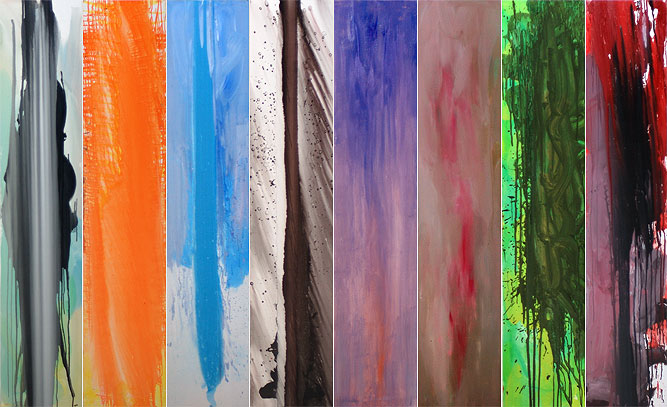
The Seven Deadly Sins / Acrylic and pigment on canvas, 2006, 250 x 50 cm
5. contemporary synthesis of the strict, hierarchical value system.
On Visual Arts Day 2006, the Seven Deadly Sins were united for the first time in a single painting in another live painting with music in the studio at the Alte Tabakfabrik. The creative environment of the studio and the freedom of musical improvisations accompanied the step towards a contemporary synthesis of the strict, hierarchical value system. The unity of the picture and the integration of the partial aspects were formally traced in the square format with the measurement 1. The square as a symbol of matter at the same time formed the antipole of the vertical of the original "Gothic" format, which was oriented towards the divine and the sky.
For the first time, the symbolism of the water hammer figures was also integrated directly into the picture here. As a black band of signs reminiscent of pictorial script, they formed the compositional beginning in the center of the canvas. Columns of color in watery, spontaneous application rose above them and overlapped them until the relics of the medieval signature were finally pushed completely to the left edge. A dynamic movement reaching out in all directions blurred and blended the strict color order of the sins in a powerful wave of color sweeping across the picture, already touching even the pillars of the order of values still visible on the right.
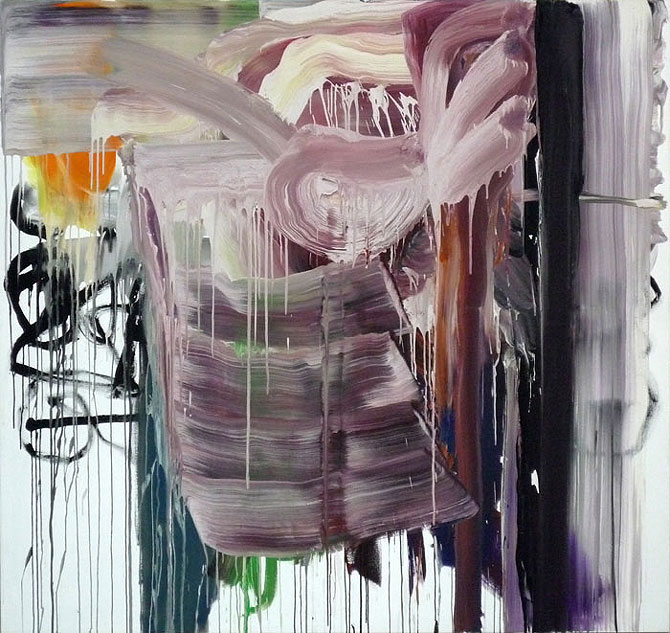
The Seven Deadly Sins / Acrylic and pigment on canvas, 2006, 170 x 180 cm
6. concentration and resolution
The final point in 2006 was the concentration and dissolution of the theme in a picture that grew into the horizontal. Associatively, the world of the water hammer figures and the color scheme of the Wintringer system are juxtaposed here in emotional gestures. The dark graphic symbols of the allegorical sculptures form the basis. From the height of the pictorial space, the eight color columns unfold in a flowing, luminous and powerful manner; they form the new superstructure and only in a few places, where they dissolve downward, do they stand in connection with the cryptic symbolism of the variety of interpretations condensed in the figures.
This live painting took place in the Beck Gallery in Homburg on the occasion of the presentation of the documentation with an audio CD of the first painting event in the chapel of the hospital in St. Wendel. Thematically as well as formally, this closed a circle of development.
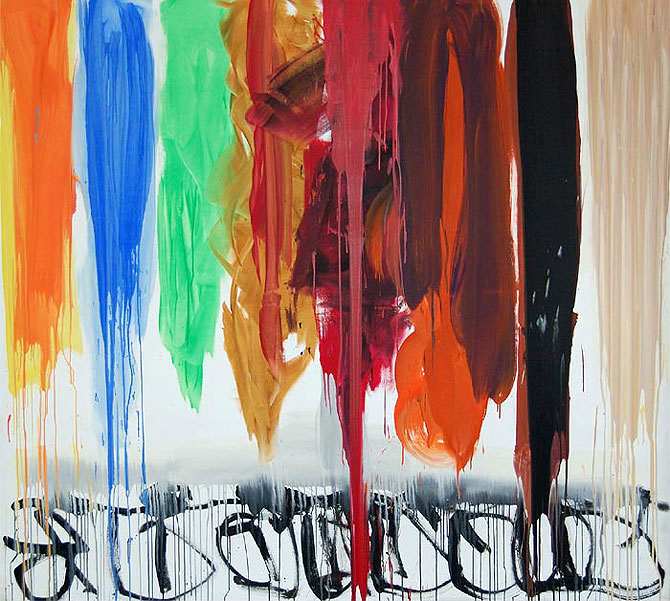
The seven deadly sins / acrylic and pigment on canvas, 2006, 200 x 220 cm
The Seven Deadly Sins in the Dialogue of the Arts
1. late medieval sculptures in the mirror of modern painting
The eight late Gothic water hammer figures on the outer buttresses were the starting point of an intense debate involving several arts. The sculptures, carved out of the sandstone 600 years ago by an unknown artist, are among the most important relics of the church history of our region. They are interpreted as allegorical representations of the seven deadly sins and an angel.
With the figurative representation of typifying characteristics and behavior, the medieval symbolic language led the way beyond representationalism into abstraction. Nikola Dimitrov follows the opposite path in his interpretation. In the negation of any depictive function in favor of a purist abstraction, he uses only the emotional expressiveness of the colors to illuminate the subject.His design means are the format of the canvas, the emotional spaces of the color compositions and the plastic character of the paint application in conjunction with the imaginative power of the picture titles.
The eight panel paintings were painted by Nikola Dimitrov in his studio. He used pure pigment of high luminosity for his large-scale free color creations. In glazing technique he layered the colors to a carefully chosen harmony. Spatialization was achieved through the contrast of dull versus shimmering, compact versus gossamer passages.
His gradient technique of forming hollows in the loosely stretched canvas gave rise to color landscapes that appear to be flowing, mutating, and moving in themselves. Until the drying process, the colors maintained a life of their own: Relief, skin and crack formations, but also corporeal formations were created by the independent growth of the gathering colors. Fascinating color gradients, subtle gradations and spatial effects give the vertical-format panel paintings a very lively, profound language.
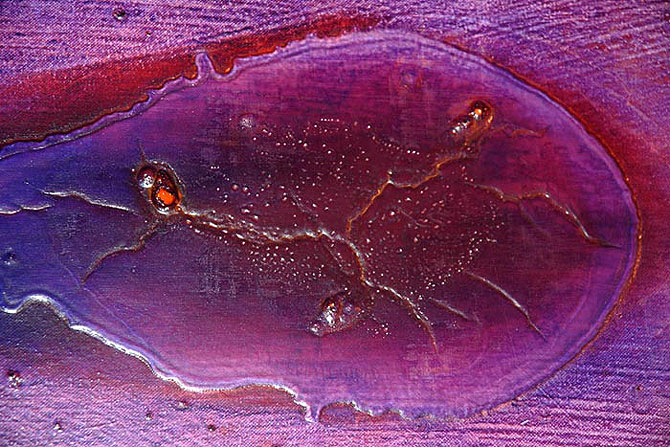
Panel picture gluttony here with a detail shot
2. transformation impulses through the dialogue between music and painting
The way out of the walls of the cultural site was accompanied by music as the inspiring source of a gradual transformation. In live paintings Nikola Dimitrov painted in dialogue with minimalist impressions and jazz variations of Bernd Mathias on piano and Stefan Scheib on bass. The stone turned picture world of the late gothic like the visualization with the means of modern painting now stood in contrast to the only audible world of sounds.
Temporal sequence, rhythm and the richness of variation in the music brought a dynamic pushing into movement into the meditative, resting imagery. The departure from the silence of the Wintringer Chapel and the contemplation of the studio into direct contact with the audience brought the deadly sin theme into the here and now.
The character of the event and the tight time frame encouraged a spontaneous, expressive and at the same time linear reduced painting.
Images from live painting: actors music and process reenactment of the creation of the image
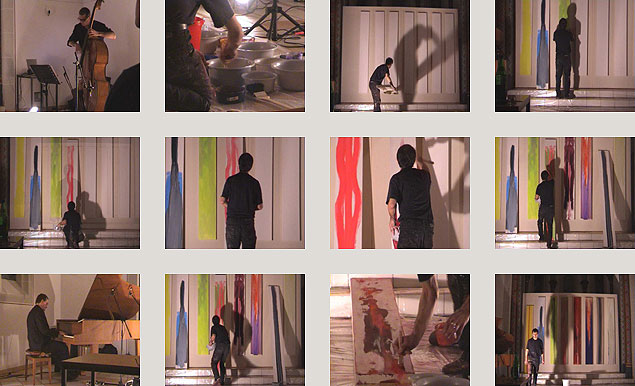
Livepainting in the hospital chapel Sankt Wendel, 2005
3. multiple reflections in images of the image
In the fruitful encounter of different arts, each artistic statement expanded the previous view and brought new aspects into play. At each location, a new level of reflection was integrated into the interpretive fabric, resulting in multiple mirrored images.
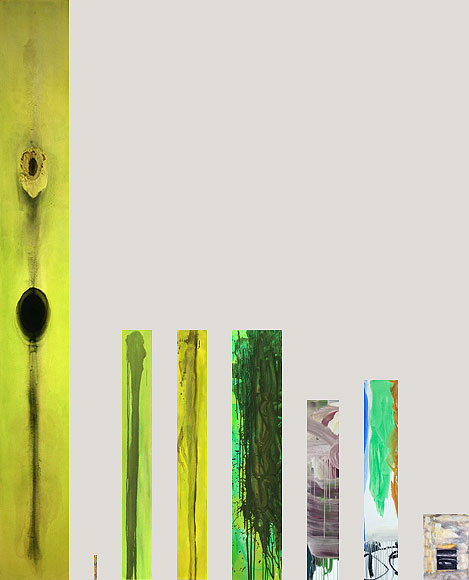
Images of a sin theme in relation to each other (here the lizard - envy) across the different artistic designs (at 5 and 6 there are excerpts from the single images of 2006)
The beginning was made by the movable plaster productions of the water hammer figures, which, independent of the building structure and the elevated position on the outside of the building, enabled an intensive examination of the plastic and gestural figurativeness. They were therefore also part of the installation in the interior of the chapel.
Black-and-white photographs of the sculptures, which lacked the immediate gestural expression of the plastic material, drew a picture rich in contrast, characterized by light and shadow. They paved the way to the two-dimensionality and polarity of painting. In the form of colored collages on paper they helped in the first further development from the original material.
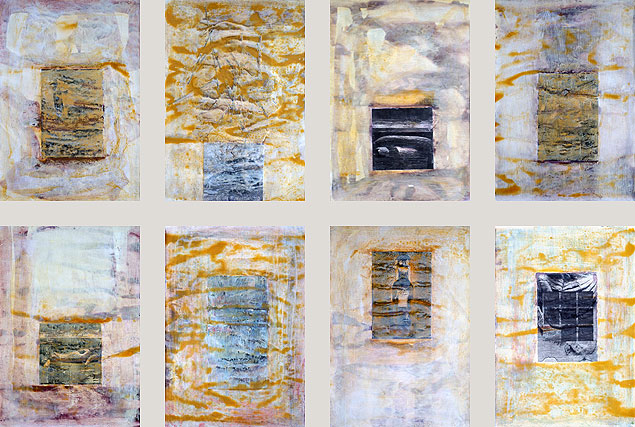
The Seven Deadly Sins / Acrylic, collage on paper, 2005, 66 x 46 cm
High-mindedness, sloth, envy, lust, anger, gluttony, avarice and the angel.
Photos of the water hammer figures and the scaled-down deadly sin cycle created a complete site-independent image of the Hibernus - exhibition in the curltural site
The cinematic documentation of the live paintings enabled further creative processing based on optical and visual conservation.
4. the development potential of an open process
The artistic echo of the Seven Deadly Sins set the stage for a multi-level, mutually influencing system of reflection that can be continued and supplemented by new artistic media of expression - by the level of the word or the song, for example, as was already tested with the vocal commentaries of the countertenor Ralf Peter during the opening.
Resonance in other spaces was and is also a possible issue. Last but not least, the oversized picture panels of the "Original" Deadly Sins await their renewed or final exhibition in suitably dimensioned spaces, where they can unfold their meditative forcefulness in communication with people.
The vision of a picture cycle visualizing the development of a new value system
Nikola Dimitrov assigns each of the 8 picture cycles that have already been created to a symbolism of a water hitting figure and thus to a mortal sin. The visionary concept, which will again deal with this theme, no longer incorporates the traditional lore, but sets itself the task of visualizing the development towards a new system of values.
www.nikoladimitrov.de